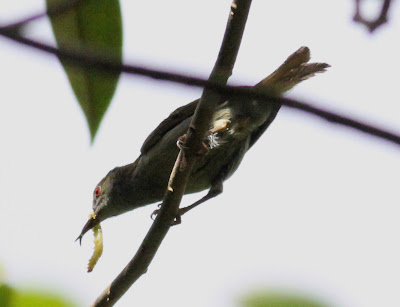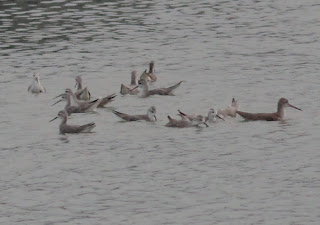Continuing from the first part......the waders such as Bar Tailed Godwits were noticeably missing so were the Sand Plovers and Common Redshanks.
 |
| Brown Shrike |
 |
| White-Winged Tern |
White winged terns continued their presence through out the morning.
Marsh Sandpipers made up the most waders counted this time.
Here's a group of them swimming like ducks with a lone common redshank.
Another group of Marsh Sandpipers which prefer not to swim.
 |
| Common Redshank |
This is the one of the only 2 redshanks spotted today.
Another Marsh Sandpiper
A Great Egret alright
 |
| Whimbrel |
 |
| Collared Kingfisher |
 |
| Terek Sandpiper |
Looks like it still has a bit of its summer plumage. Just like the Wimbrels, it was seen chasing after small crabs to eat.
A Crested Little Heron?
Unidentified Pond Heron
(Note: an expert says this could be an Indian Pond Heron)
David versus Goliath.
These fighting crabs provided some entertainment in the absence of the waders.
I believe this is a Common Fence Lizard
Here is a summary of some of the birds seen:
Date: 11 December 2012
Time: 7.15am - 11.00am
Eurasian Curlews (N
umenius arquata) = 10
Common Sandpiper (
Actitis hypoleucos) = 15
Grey Heron (
Ardea cinerea) = 6 (with two hatchlings)
Common Greenshank (
Tringa nebularia) = 5
Marsh Sandpiper (
Tringa stagnatilis) = 30
Common Redshank (
Tringa Totanus) = 2
Whiskered Tern (
Chlidonias hybridus) = 25
White-Winged Tern (
Chlidonias leucopterus) = 15
Whimbrel (
Numenius phaeopus) = 5
Terek Sandpiper (
Xenus cinereus) = 3
Lesser Sandplover (
Charadrius momgolus) = 2
Little Egret (
Egretta garzetta) = 2
Great Egret (
Casmerodius albus) = 1
Collared Kingfisher (
Todiramphus chloris) = 5
Common Kingfisher (
Alcedo atthis) = 1
Brown Shrike (
Lanius cristatus) = 1
Blue-Tailed Bee Eater (
Merops philippinus) = 5
Brahminy Kite (
Haliastur indus) = 1
Paddy-Field Pipit (
Anthus rufulus) = 1
Red junglefowl (
Gallus gallus) = 1 (heard call only)
Unidentified Pond Heron = 3
Hope all these info will be of some use to the Asian Waterbird Census which would usually be held in the month of January each year.










































